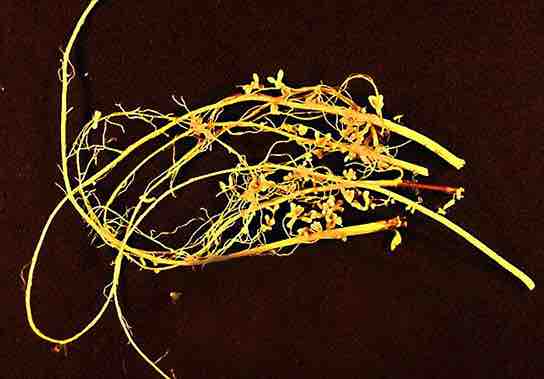Cooperation between Bacteria and Eukaryotes: Nitrogen Fixation
Nitrogen is a very important element for living things because it is part of the nucleotides and amino acids that are the building blocks of nucleic acids and proteins, respectively. Nitrogen is usually the most limiting element in terrestrial ecosystems. Atmospheric nitrogen, N2, provides the largest pool of available nitrogen. However, eukaryotes cannot use atmospheric, gaseous nitrogen to synthesize macromolecules. Fortunately, nitrogen can be "fixed," meaning it is converted into ammonia (NH3) either biologically or abiotically. Abiotic nitrogen fixation occurs as a result of lightning or by industrial processes.
Bacterial Nitrogen Fixation
Biological nitrogen fixation (BNF) is exclusively carried out by prokaryotes: soil bacteria, cyanobacteria, and Frankia spp. (filamentous bacteria interacting with actinorhizal plants such as alder, bayberry, and sweet fern). After photosynthesis and cellular respiration, BNF is the second most important biological process on Earth. The equation representing the process is as follows, where Pi stands for inorganic phosphate: N2 + 16ATP + 8− + 8H+ 2NH3 + 16ADP + 16Pi + H2
The total fixed nitrogen through BNF is about 100 to 180 million metric tons per year. Biological processes contribute 65 percent of the nitrogen used in agriculture.
Types of Bacteria
Cyanobacteria are the most important nitrogen fixers in aquatic environments. In soil, members of the genus Clostridium are examples of free-living, nitrogen-fixing bacteria. Other bacteria live symbiotically with legume plants, providing the most important source of BNF. Symbionts may fix more nitrogen in soils than free-living organisms by a factor of 10. Soil bacteria, collectively called rhizobia, are able to symbiotically interact with legumes to form nodules: specialized structures where nitrogen fixation occurs . Nitrogenase, the enzyme that fixes nitrogen, is inactivated by oxygen, so the nodule provides an oxygen-free area for nitrogen fixation to take place. This process provides a natural and inexpensive plant fertilizer as it converts (reduces) atmospheric nitrogen to ammonia, which is easily usable by plants. The use of legumes is an excellent alternative to chemical fertilization and is of special interest to sustainable agriculture, which seeks to minimize the use of chemicals and conserve natural resources. Through symbiotic nitrogen fixation, the plant benefits from using an endless source of nitrogen: the atmosphere. Bacteria benefit from using photosynthates (carbohydrates produced during photosynthesis) from the plant and having a protected niche. Additionally, the soil benefits from being naturally fertilized. Therefore, the use of rhizobia as biofertilizers is a sustainable practice.

Location of Nitrogen Fixation
Soybean (Glycine max) is a legume that interacts symbiotically with the soil bacterium Bradyrhizobium japonicum to form specialized structures on the roots called nodules where nitrogen fixation occurs.
Some legumes, like soybeans, are also key sources of agricultural protein. Some of the most important legumes are soybean, peanuts, peas, chickpeas, and beans. Other legumes, such as alfalfa, are used to feed cattle.